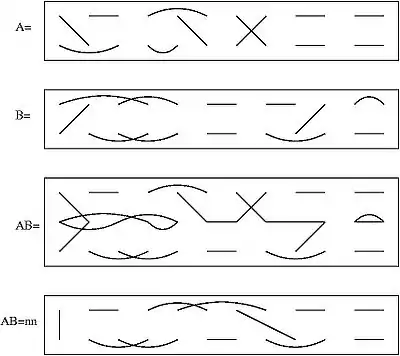Brauer algebra
In mathematics, a Brauer algebra is an algebra introduced by Richard Brauer (1937, section 5) used in the representation theory of the orthogonal group. It plays the same role that the symmetric group does for the representation theory of the general linear group in Schur–Weyl duality.
Definition
In terms of diagrams

The Brauer algebra is a -algebra depending on the choice of a positive integer n. is an indeterminant, but in practice is often specialised to the dimension of the fundamental representation of an orthogonal group . The Brauer algebra has dimension and has a basis consisting of all pairings on a set of elements (that is, all perfect matchings of a complete graph : any two of the elements may be matched to each other, regardless of their symbols). The elements are usually written in a row, with the elements beneath them. The product of two basis elements and is obtained by first identifying the endpoints in the bottom row of and the top row of (Figure AB in the diagram), then deleting the endpoints in the middle row and joining endpoints in the remaining two rows if they are joined, directly or by a path, in AB (Figure AB=nn in the diagram). Thereby all closed loops in the middle of AB are removed. The product of the basis elements is then defined to be the basis element corresponding to the new pairing multiplied by where is the number of deleted loops. In the example .
In terms of generators and relations
can also be defined as the -algebra with generators satisfying the following relations:
- Relations of the symmetric group:
- whenever
- Almost-idempotent relation:
- Commutation:
- whenever
- Tangle relations
- Untwisting:
- :
In this presentation represents the diagram in which is always connected to directly beneath it except for and which are connected to ans respectively. Similarly represents the diagram in which is always connected to directly beneath it except for being connected to and to .
Properties
The subalgebra generated by the is the group algebra of the symmetric group. The Brauer algebra is a cellular algebra.
Action on tensor powers
Let be a euclidean vector space of dimension . Then write for the specialisation where acts on by multiplication with . The tensor power is naturally a -module: acts by switching the th and th tensor factor and acts by contraction followed by expansion in the th and th tensor factor, i.e. acts as
where is any orthonormal basis of (the sum is in fact independent of the choice of such a basis).
This action is useful in a generalisation of the Schur-Weyl duality: The image of inside is exactly the centraliser of inside and vice versa. The tensor power is therefore both an - and a -module and satisfies
where runs over certain partitions and are the irreducible - and -module associated with respectively.
The orthogonal group
If Od(R) is the orthogonal group acting on V = Rd, then the Brauer algebra has a natural action on the space of polynomials on Vn commuting with the action of the orthogonal group.
See also
- Birman–Wenzl algebra, a deformation of the Brauer algebra.
References
- Brauer, Richard (1937), "On Algebras Which are Connected with the Semisimple Continuous Groups", Annals of Mathematics, Second Series, Annals of Mathematics, 38 (4): 857–872, doi:10.2307/1968843, ISSN 0003-486X, JSTOR 1968843
- Wenzl, Hans (1988), "On the structure of Brauer's centralizer algebras", Annals of Mathematics, Second Series, 128 (1): 173–193, doi:10.2307/1971466, ISSN 0003-486X, JSTOR 1971466, MR 0951511
- Weyl, Hermann (1946), The Classical Groups: Their Invariants and Representations, Princeton University Press, ISBN 978-0-691-05756-9, MR 0000255, retrieved 03/2007/26 Check date values in:
|access-date=(help)